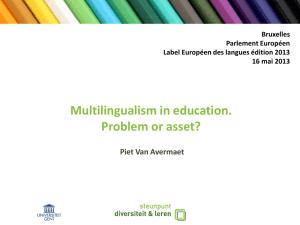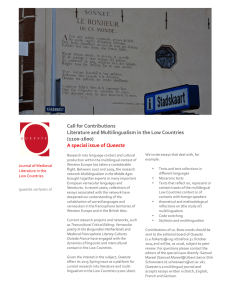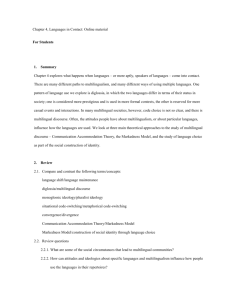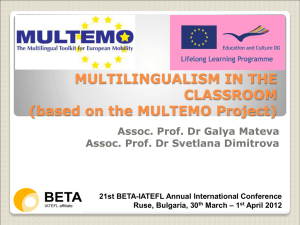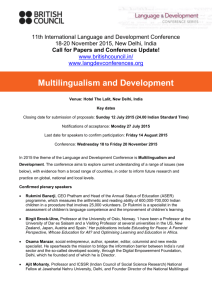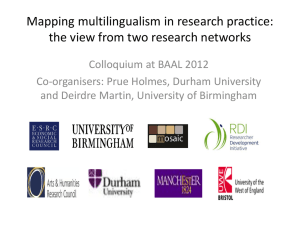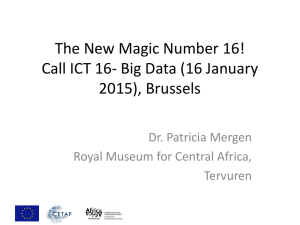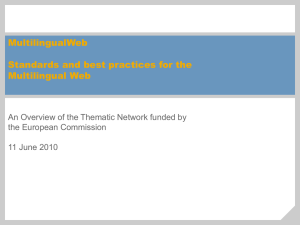Piet Van Avermaet
advertisement
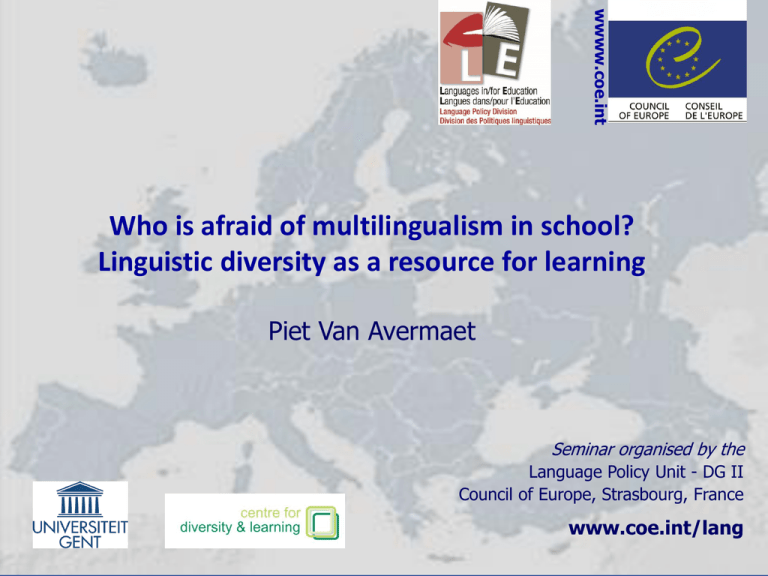
wwww.coe.int Who is afraid of multilingualism in school? Linguistic diversity as a resource for learning Piet Van Avermaet Seminar organised by the Language Policy Unit - DG II Council of Europe, Strasbourg, France www.coe.int/lang “To reject a child’s language in the school is to reject the child. When the message, implicit or explicit, communicated to children in the school is “Leave your language and culture at the schoolhouse door”, children also leave a central part of who they are - their identities - at the schoolhouse door. When they feel this rejection, they are much less likely to participate actively and confidently in classroom instruction” (Cummins, 2001, p. 19). We all have questions? • How do I deal with the multilingual reality in classrooms? – Forbid/suppress – Using them in the learning process? – Teach them? • What is the impact of suppressing/making use of it/teaching them?: cognitively, socio-emotional? • How do we communicate with parents? • What do we advise migrant parents to speak at home? • … • Many questions? • www.meertaligheid.be Teachers’ concerns • • • • • • Parents don’t want it! Childrens’ L1 is poor, restricted. Allowing the use of L1 paves the way to segregation. I lose control of what happens in the classroom. The time to learn L2 is already so limited. I have more than 10 languages in my classroom. School in Flanders (2009) “In the interest of your child we speak Dutch here. And you?” Multilingual reality • Multilingualism a reality in all European societies, especially in urban spaces • In schools and classrooms more and more ‘superdiversity’ • Multilingualism is a reality in every person: plurilingual repertoires • ‘Good’ and ‘bad’ multilingualism Within a context where ‘super diversity’ is becoming the norm it is important to reflect on the boundaries of the current recipes that are being used in systems of (language) education. As concepts like language, citizenship, learning, ... are social constructs we have to consider reconstructing them, given the new social contexts. Theoretical framework: multilingual education vs. L2 submersion • Central question: which language education model is more effective for L2 acquisition as well as for closing the ‘achievement gap’? • Search for ‘one-size-fits-all’ model -> polarization – L2 submersion (L2-only): • Competition between languages ;negative transfer • ‘Sponge’: young children are ‘automatic’ L2-learners • Time on task / frequency of input: maximum L2 exposure & exclusion of L1’s – (Bi)-Multilingual education: • Positive relationships between higher-order language skills (Cummins) • Positive transfer L1-L2 • Facilitation / scaffolding (constructivist learning) Traditional bilingual education – Separation arrangement: • Spatial: separate, homogeneous classes/schools • Temporal: separate lessons • Segregated groups of learners • Compartmentalized languages (Cummins, 2008) • Multilingualism = parallel monolingualisms (Creese & Blackledge, 2010) – Educational arrangement: • instruction by bilingual teachers • Overall low involvement of mainstream teachers Multilingual education: towards a new approach? • Arguments – Practical: is organization of bi-/multilingual education in urban heterogeneous schools feasible? – Theoretical: new sociolinguistic conceptions of multilingual communication in the complex contemporary world which break with ‘received’ ideas Functional plurilingual learning • Plurilingual repertoires as resource for learning: – Repertoires as didactical capital for learning: – functional use of home languages in multilingual, L2dominant learning environments • Setting: – Linguistically mixed mainstream classes – Integrated: L1 and L2 learners – L2 is dominant, but there are opportunities for concurrent use of various languages – Teachers do not have to speak (all) present L1’s Functional plurilingual learning • L1 as a tool for learning : scaffolding model – – – – Socio-cognitive: L1’s as a cognitive and didactic asset Socio-cultural theories -> Vygotsky Instructional strategies Positive interdependency between ‘higer-order’ language skills Functional plurilingual learning • Conditions: – From empirical research it is clear that ‘functional plurilingual learning’ can only be effective when it is structurally embedded in a school policy that opt for a multilingual perspective – From empirical research we also learn that creating ‘powerful learning environments’ is a fundamental condition Powerful multilingual learning environment Safe and positive classroom environment: L1 to comfort, open climate, children are appreciated, self-confident Functional and meaningful activities with L1 as a means to reach a real-life goal Interactional support by teachers or peers in L1 Research project “Home language in education” (HLE) Funded by Ghent municipality conducted by UGent and KULeuven HLE-project: objectives • Objective A: The use of multilinguality (diverse linguistic capital) in plurilingual powerful learning environments • Objective B: Academic literacy development in L1 Baseline study findings Teachers (observations & interviews): – Dominant monolingual L2 submersion model: • Banning of L1’s from the classroom, esp. in primary • Maximum L2 exposure • Multilingualism has no cognitive & linguistic surplus value – Shift concerning L1 usage at home • L1 maintenance (additive bilingualism): L1 outside school is not explicitly discouraged anymore – Shift with some preschool teachers • Spontaneous L1 tolerance within the classroom • Incipient L1-related practices facilitating well-being (L1 has positive socio-emotional function: to feel at home in school) Baseline study findings Before the project: “the children were not allowed to speak their ‘own language’” “we used to punish those children that spoke their home language. That was very common” “their was little interaction. September 1th, the children knew that they were only allowed to speak Dutch. I presented myself and nobody said anything. All children staid silent. Their proficiency in Dutch was insufficient and they were not allowed to speak their home language. So their was simply no interaction” Test score Turkish and Dutch Process evaluation: interim observations 2009-2010 in preschool classes Teachers’ perceptions (1) At the level of positive learning environment Through the use of L1 more tolerance: “If, for instance, a child uses an Arabic word, Turkish children will try to pronounce it and want to learn it. This was not the case before the project. Then the Turkish children would have said ‘bah, Arabic’.” (K3) “since the project the children are more tolerant to each other regarding the use of their home language” Added value of the use of L1: “the children rapidly felt that they were allowed to use their home language and that they could make themselves better understand and could help each other” Teachers’ perceptions (1) At the level of positive learning environment More involvement of the children: “The added value is that before a child often said nothing and was very passive, it didn’t learn. That same child now is actively involved, talks all the time and learns by doing.” (K3) “ I notice already now that children are more talkative when entering the classroom and are not afraid to ask something.“ (K2-3) Teachers’ perceptions (2) At the level of meaningful activities Impact on L2 learning “Children now want to learn more Dutch. They ask more for it than before.” (K3) “Two Turkish children who were talking about a lobster in Turkish and spontaneously asked me ‘what is this in Dutch?’. And they kept repeating the word in Dutch.” (K3) More awareness of multilingualism “Language sensitizing tasks make me aware of the children’s multilingualism. What we [as teachers] experience as something ‘special’ is common for the children.” (K3) Powerful plurilingual learning environment Safe and positive classroom environment: L1 to comfort, open climate, children are appreciated, self-confident Functional and meaningful activities with L1 as a means to reach a real-life goal Interactional support by peers in L1 Awareness of parents “A mother who spontaneously said to me ‘I didn’t know that my child new all these animals in Turkish” “A lot of parents who are now more involved with their children than before.” Parents as partners “Parents feel more at home in school because the L1 is present. […] They are often invited to help in the classroom e.g. by reading a story in L1.” (K2-3) Teachers’ perceptions (3) At the level of support through interaction Children helping each other “They rapidly started to help each other. When I said something and one of the children didn’t understand what I said, another child started to repeat it in the home language.” (K3) “I am not able to give feedback in a child’s home language but other children can definitely do that.” (K2-3) Teachers’ perceptions (3) At the level of support through interaction Use of L1 does not slow down L2 learning “Since the project started, I have the impression that they already know more words in Dutch than children I had in my classroom before it was allowed to use the home language.” (K3) The teacher as an ‘outsider’ “I often wonder what is going on in the head of the children. It’s a pity I don’t understand what they say when they use the L1.” (K3) Powerful plurilingual learning environment Safe and positive classroom environment: L1 to comfort, open climate, children are appreciated, self-confident Functional and meaningful activities with L1 as a means to reach a real-life goal Interactional support by teachers or peers in L1 It starts with a positive attitude “It starts with a positive attitude, but also being well informed what the project is exactly about and how the school looks at it. The vision of the school.” Conclusions • Confirmation of Cummins’ linguistic interdependency hypothesis at beginning of project; • Shift from monolingual school policy and classroom practice to functional plurilingual teaching/learning go hand in hand with an observed shift from instructivist pedagogy to more social constructivist paradigm of learning. – When allowing to use L1, indications of a more powerful learning environment – Positive shift towards power of co-teaching Conclusions • FPTL seems to be more powerful and seems to have more potential than traditional compartimentalised bilingual learning. In superdiverse classrooms using the plurilingual repertoires of children is taken as an asset, a resource for learning • More involvement of teacher; of children; more interaction taking place in the classroom Conclusions • Positive impact on teachers’ beliefs and perceptions • Teacher as an active agent in processes of the reconstruction of old ‘recipes’: – – – – Training, coaching, feedback, co-reflection, co-construction Empowerment and increased positive awareness of parents co-construction with parents; parents as active stakeholders Increase parental involvement and of change in parents beliefs in role of L1 as good practice in classrooms (schools as local agents; change from below) – Teachers see positive effects of use of L1 on L2 learning Change paradigm Shift in perception, beliefs From what children cannot Into what they can. Otherwise we will lose a whole generation of children (not only migrants) http://www.youtube.com/watch_po pup?v=aRG4ySdi_aE&vq=medium wwww.coe.int THANK YOU piet.vanavermaet@ugent.be Language Policy Unit - DG II Council of Europe, Strasbourg, France www.coe.int/lang
